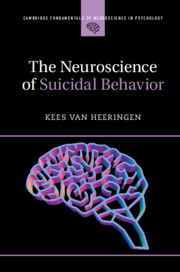
-
Select format
-
- Publisher:
- Cambridge University Press
- Publication date:
- May 2019
- August 2018
- ISBN:
- 9781316563205
- 9781107148949
- 9781316602904
- Dimensions:
- (228 x 152 mm)
- Weight & Pages:
- 0.59kg, 286 Pages
- Dimensions:
- (228 x 152 mm)
- Weight & Pages:
- 0.48kg, 286 Pages
You may already have access via personal or institutional login
Book description
Nearly one million people take their own lives each year world-wide - however, contrary to popular belief, suicide can be prevented. While suicide is commonly thought to be an understandable reaction to severe stress, it is actually an abnormal reaction to regular situations. Something more than unbearable stress is needed to explain suicide, and neuroscience shows what this is, how it is caused and how it can be treated. Professor Kees van Heeringen describes findings from neuroscientific research on suicide, using various approaches from population genetics to brain imaging. Compelling evidence is reviewed that shows how and why genetic characteristics or early traumatic experiences may lead to a specific predisposition that makes people vulnerable to triggering life events. Neuroscientific studies are yielding results that provide insight into how the risk of suicide may develop; ultimately demonstrating how suicide can be prevented.
Reviews
'… van Heeringen has made the neuroscience of suicide accessible, understandable, non-intimidating, reader-friendly, and actually rather interesting …'
Alan L. Berman Source: The Journal of Crisis Intervention and Suicide Prevention
Contents
Metrics
Altmetric attention score
Full text views
Full text views help Loading metrics...
Loading metrics...
* Views captured on Cambridge Core between #date#. This data will be updated every 24 hours.
Usage data cannot currently be displayed.
Accessibility standard: Unknown
Why this information is here
This section outlines the accessibility features of this content - including support for screen readers, full keyboard navigation and high-contrast display options. This may not be relevant for you.
Accessibility Information
Accessibility compliance for the PDF of this book is currently unknown and may be updated in the future.


